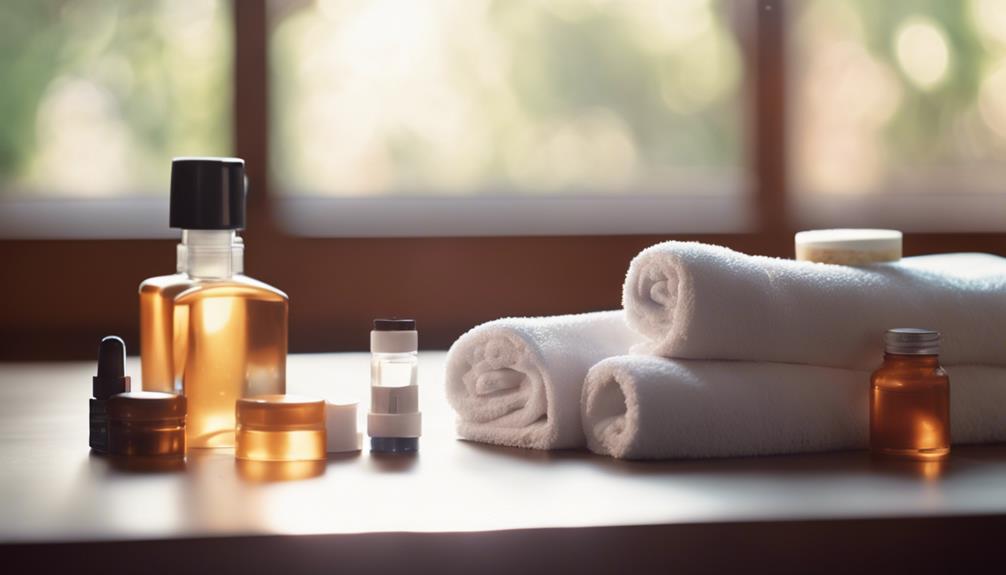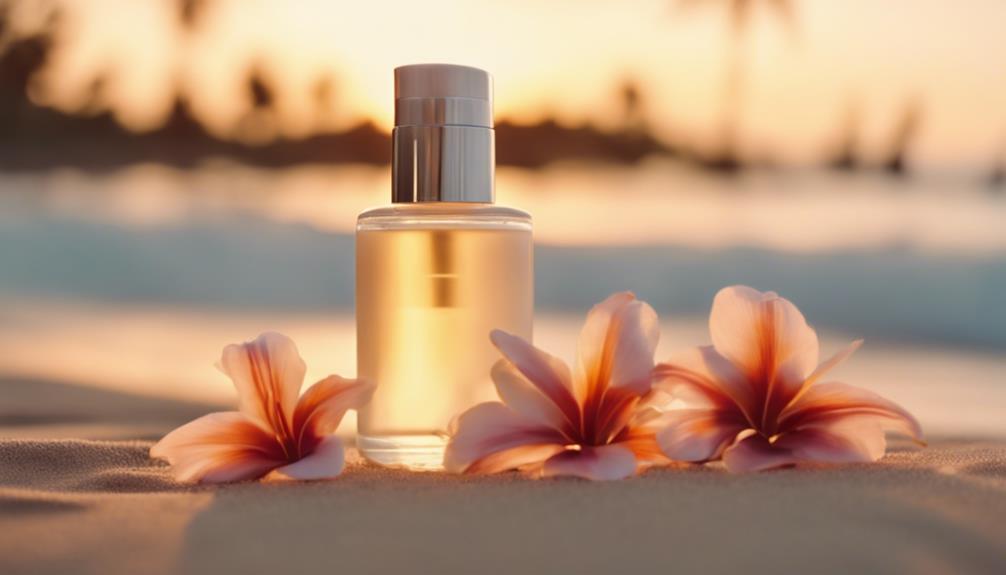To guarantee a safe tanning experience, start by evaluating your skin type and sensitivity. Always wear UV-blocking goggles to protect your eyes and begin with short sessions of 3-5 minutes in low-intensity beds. Gradually increase exposure time based on how your skin reacts. Use a lightweight, non-oil-based moisturizer to prepare your skin and choose indoor tanning lotions designed for UV exposure. After tanning, apply a moisturizer to replenish skin hydration. Staying hydrated is key, too. Follow these tips, and you'll set yourself up for a great tanning journey while discovering even more helpful insights along the way.
Key Takeaways
- Always wear UV-blocking goggles to protect your eyes from harmful rays during tanning sessions.
- Start with low-intensity tanning beds and limit initial sessions to 3-5 minutes.
- Gradually increase exposure time based on your skin's reaction to avoid burns and irritation.
- Exfoliate and moisturize your skin prior to tanning for better tan absorption and longevity.
Skin Assessment and Preparation
Before you step into the tanning bed, it's essential to assess your skin type and prepare properly to guarantee a safe and effective tanning experience.
Start by identifying your skin's sensitivity level, as this'll help you determine your tanning routine and UV exposure limits. Consulting a tanning expert can provide personalized advice tailored to your needs.
You should also exfoliate and hydrate your skin at least a day before tanning; using a lightweight, non-oil-based moisturizer can enhance tan absorption.
Remember to check any medications you're taking for potential UV sensitivity.
Protective Measures

Wearing protective clothing and eyewear is essential to safeguarding your skin and eyes during tanning sessions. To guarantee safety, invest in UV-blocking goggles, as closed eyes won't protect against harmful rays. Snug swimwear or protective clothing can cover sensitive areas, helping you avoid unwanted burns. Consider using tanning stickers to monitor your bronzing progress and guarantee even exposure.
| Protective Gear | Purpose |
|---|---|
| UV-Blocking Goggles | Protect eyes from UV rays |
| Snug Swimwear | Cover sensitive skin |
| Tanning Stickers | Track tanning progress |
Lotion Selection and Application

Choosing the right indoor tanning lotion is key to achieving an even, long-lasting tan while protecting your skin during sessions.
Look for lotions specifically designed for UV exposure, as they provide the hydration your skin needs. Apply the lotion using circular motions to guarantee even coverage, but be careful not to over-apply, which can lead to streaking.
Consider bronzing formulas to boost melanin production for a deeper tan. After your tanning session, use a tan extender to prolong your results.
Understanding Exposure Limits

Understanding your skin's UV tolerance is essential for safe tanning and avoiding overexposure. Each person's skin reacts differently, so you need to pay attention to your body. To guarantee you're tanning safely, follow these guidelines:
- Know Your Skin Type: Identify your skin type and its sensitivity to UV rays.
- Start Small: Begin with short sessions of 3-5 minutes to test your skin's reaction.
- Gradually Increase Time: If your skin responds well, slowly increase your exposure time in future sessions.
- Monitor Your Skin: Keep a close eye on your skin's condition after each session to prevent burns or irritation.
Medication Interactions

Certain medications can increase your skin's sensitivity to UV rays, making it vital to be aware of potential risks before tanning.
Before your session, check if you're taking any photosensitive drugs, such as certain antibiotics, anti-inflammatory medications, or acne treatments. These can heighten the chances of sunburn or skin irritation.
It's a good idea to consult your healthcare provider about any medications you're on and their potential interactions with tanning.
Additionally, make sure you keep your skin moisturized during tanning to help protect it.
Don't forget to use protective eyewear, as it's important to shield your eyes from harmful UV exposure.
Being informed and prepared will help you enjoy a safer tanning experience.
Post-Tanning Care

Applying moisturizer immediately after tanning is essential to replenish moisture and enhance the longevity of your tan.
To keep your skin healthy and your tan glowing, follow these four post-tanning care tips:
- Use Aloe Vera: Apply aloe vera gel to soothe your skin and help maintain color.
- Stay Hydrated: Drink plenty of water to keep your skin hydrated from the inside out.
- Gentle Skincare: Stick to a gentle skincare routine; avoid harsh cleansers or exfoliants that could strip your tan.
- Moisturize Daily: Continue to apply a hydrating lotion daily to prolong your tan and keep your skin soft.
Safety Tips for Beginners

Before diving into tanning, it's crucial to recognize your skin's limits to prevent overexposure and burns.
Always wear protective goggles during your sessions; your eyes need proper shielding from UV rays.
Start with low-intensity beds and keep your sessions short—around 3 to 5 minutes—to gauge how your skin reacts.
Approach tanning as a gradual learning process; consistency is key.
Schedule regular sessions, but don't rush the process—allow your skin time to adjust.
Pay attention to your skin's condition and avoid tanning if you notice any irritation.
Finally, remember to stay hydrated and moisturize your skin post-tanning to maintain your glow and overall skin health.
Following these tips will help you achieve that sun-kissed look safely.
Frequently Asked Questions
How Often Should I Tan for Optimal Results?
To achieve ideal tanning results, you should tan 1-3 times a week, depending on your skin type. Monitor your skin's reaction and adjust the frequency to avoid overexposure and maintain a healthy glow.
Can I Tan if I Have a Sunburn?
You shouldn't tan if you have a sunburn. Tanning can worsen the burn and increase skin damage. Instead, focus on healing your skin first, then resume tanning once it's fully recovered and healthy.
What Happens if I Fall Asleep in the Tanning Bed?
If you fall asleep in the tanning bed, you risk overexposure to UV rays, leading to sunburn, skin damage, or even heat exhaustion. Always set a timer and stay aware during your tanning sessions.
Are There Specific Tanning Beds Recommended for Sensitive Skin?
When searching for tanning beds, consider options with lower UV output, adjustable settings, and gentle bulbs. These features cater to sensitive skin, helping you achieve a tan without risking irritation or burns. Always consult professionals first.
How Can I Tell if My Tan Is Developing Properly?
To tell if your tan's developing properly, monitor your skin's color daily. Look for a gradual bronze hue without irritation or redness. If you notice any discomfort, reduce exposure time or consult a tanning expert.
Conclusion
As you step into the world of tanning, remember that your skin is like a canvas, deserving of careful strokes and vibrant hues.
By following these essential safety tips, you're not just chasing a golden glow; you're embracing a journey of self-care and awareness.
Keep your skin protected, informed, and nourished, and you'll emerge from your tanning experience radiant and revitalized, like a sunflower turning towards the sun—beautiful, confident, and glowing from within.










